
Why (and How) I Built ClassPass x Instagram for Fitness with Friends (Without Writing a Line of Code)
Originally posted on Medium.
Imagine if an app could actually motivate you to workout and strengthen your exercise habit?
That’s what I attempted to make with Pemvee: ClassPass x Instagram for fitness with friends.
Below I’ll explain:
- Why I built Pemvee (and what the exercise system is)
- How I built Pemvee (without writing a single line of code using Glideapps)
- What’s next for Pemvee (and my thoughts on the current state + future of social fitness networks)
I think it’s helpful to check out the app before continuing as it puts everything in context (note: due to how the app is built you need to sign in with email). I’ve included screenshots below of the main tabs:
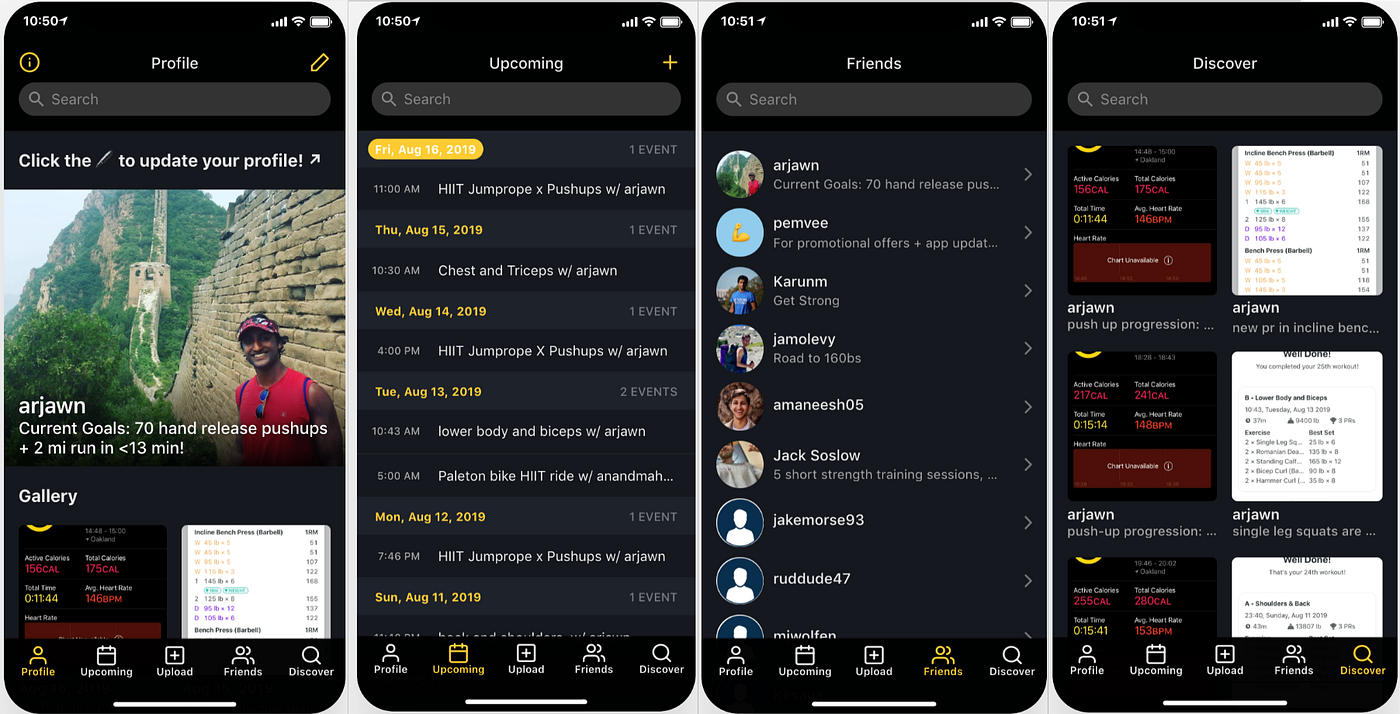
You can also find a Tweet Thread version of this post here.
Why I built Pemvee
Build Something You Want
Why is it so important to work on a problem you have? Among other things, it ensures the problem really exists.
Paul Graham
I built Pemvee because it was something I personally wanted to exist and I thought nothing exactly like it existed today.
But why did I want to it to exist? Because I personally wanted to go from being someone who inconsistently-consistently works out to someone who rarely skips a workout. Inconsistently-consistently is not a typo. Here is what that means to me in terms of exercise:
- Start a new workout plan.
- Consistently exercise 3+ times a week. I feel good.
- This continues for X weeks. I feel great.
- I miss one workout… then two… then next thing you know “I’m taking a rest week”(or longer)
- I tell myself “enough is enough” I’m starting to workout again on Monday
- Back to step 1. The cycle repeats.
This is the cycle of inconsistently-consistently exercising.
Although I think Pemvee helps create a system to strengthen my exercise habit and consistently exercise, the truth is when I first thought of the general idea I wasn’t thinking in terms of “systems” and “habits”. I just wanted three things:
- A way to make all exercise “public” before it happens (similar to ClassPass but across all exercise, not just group workout classes)
- An easier way to coordinate exercise with friends (vs sending emails and / or texts)
- A centralized app for my entire workout history (similar to an Instagram profile but for exercise only)
Again, these were things I personally wanted. This does not mean everyone else wants an app that solves these problems. This also does not mean that the lack of these things implies a “hair on fire” problem exists for everyone else.
But what excited me about building Pemvee is that I was building something that I really wanted. And therefore, the “worst-case scenario” was… actually not that bad:
- If I am the only person to use Pemvee but it actually helps me strengthen my exercise habits, then that is a great outcome.
- If 5 people use Pemvee and I can help them strengthen their exercise habits, then that is a fantastic outcome.
- And if 100s or 1000s of people (or more) use Pemvee, then I would be ecstatic.
Put differently:
- In the best-case scenario, the system and app I’ve built is used by many people to strengthen their exercise habits
- In the worst-case scenario, this is my personal app used to strengthen my exercise habits (I could even rename the app to “Argym” = “Arjun’s Gym” 😄).
And that’s what makes building something you want so enjoyable: because it’s the ultimate win-win scenario.
My Health & Fitness Flywheel
We have habits everywhere in our lives, but certain routines — keystone habits — lead to a cascade of other actions because of them.
Charles Duhigg, The Power of Habit
I believe that one’s “health and fitness” is a combination of three things:
All three are crucial and if one component is missing in totality, the other two will fall apart. I stated that I built Pemvee to strengthen my exercise habits but a question I asked myself throughout this process was: why not build an app to strengthen my dietary habits? Or recovery habits?
Why start with exercise?
It’s because exercise is my keystone habit. When I exercise I do not want to put unhealthy food in my body. I almost can’t help but eat healthily. And when I exercise I can’t help but sleep more because my body automatically requires more rest and I better prioritize sleep knowing it will help improve my results in the gym.
Put differently: When I exercise everything becomes easier.
In the following explanation of a flywheel, for me personally, exercise is A, diet is B and recovery is C:
A flywheel is an underlying, compelling logic of momentum. It’s not a list of steps. Drawn as a circle, called the flywheel. Rather, there’s an inevitability built in. If you do A [exercise], you almost can’t help but do B. And if you do B, you almost can’t help but do C… And it’s driven around because there’s an underlying connection. There’s a logical sequence that builds dynamic momentum, because A drives B drives C … and around back to the top of the loop.
Jim Collins


I was curious if other people also consider exercise to be their keystone habit and sure enough, I found two people.
Naval Ravikant, a co-founder of AngelList + an investor, talks about how exercise can automatically fix all kinds of other bad habits you have:
The most important thing is just doing some kind of physical activity every single day. And if you can make it the same activity at the same time because that right then will teach you the power of habit. If you do something 7 days a week with no exceptions and you workout early in the morning or when you first get up then it will automatically fix all kinds of other bad habits that you have. You can’t be out drinking late at night. You can’t be out partying. You can’t sleep in. You can’t consume too much caffeine. There are all kinds of other habits in your life that may be bad that get fixed if you stick to your daily workout habit and then it teaches you what the power of a habit is and then as you shed other bad habits then you realize that habits can be broken and you start breaking them.
Naval Ravikant on the Tim Ferriss Show @ 32:10
Additionally, James Clear, author of Atomic Habits and creator of the Habits Academy, explains how exercise naturally pushes him towards his best self:
When I worked out, I wanted to eat better. Even though I could have rewarded myself with chocolate bars and ice cream, I felt like eating real, healthy foods.
I also slept better. And when I was awake, I seemed more productive. Especially in the hour or two after working out, when my mind seemed to think clearer and my writing was crisper. Thoughts flowed easily.
When I didn’t exercise, however, I was more prone to eating junk food. I would stay up later working on unimportant tasks. I started to feel tension in my back. I didn’t check it, but my guess is that my blood pressure raised as a result of additional stress and no place to release it.
In other words, fitness is the keystone habit that puts the rest of my life in place. When I workout, other things naturally fall into place. I don’t have to think about eating better. I don’t have to force myself to focus on getting things done. Exercise naturally pushes me towards my best self.
James Clear
This got me thinking: is everyone’s keystone habit exercise? To quickly test this I asked Twitter. The answer? A resounding no:
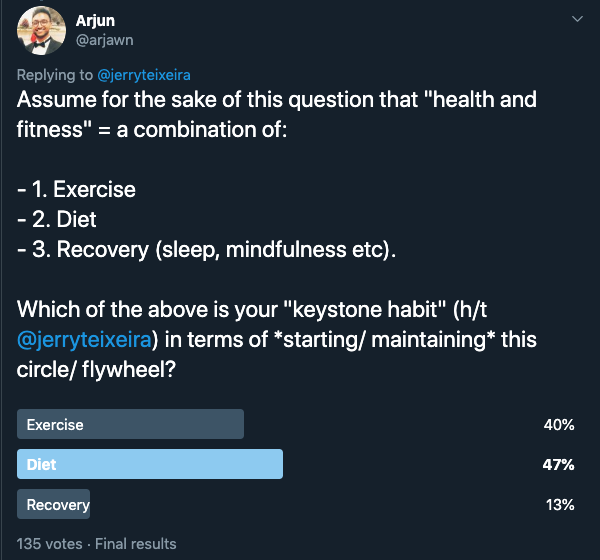

However, I realized that this was not a bad thing. One’s keystone habit doesn’t have to be exercise. It’s just important that you have a keystone habit in the first place. That being said, even if you have a different keystone habit, the strategies below that I used to strengthen my exercise habit can be applied to diet, recovery (and as I came to realize, a lot more things).
The Pemvee Habit Loop
Motivation is what gets you started. Habit is what keeps you going
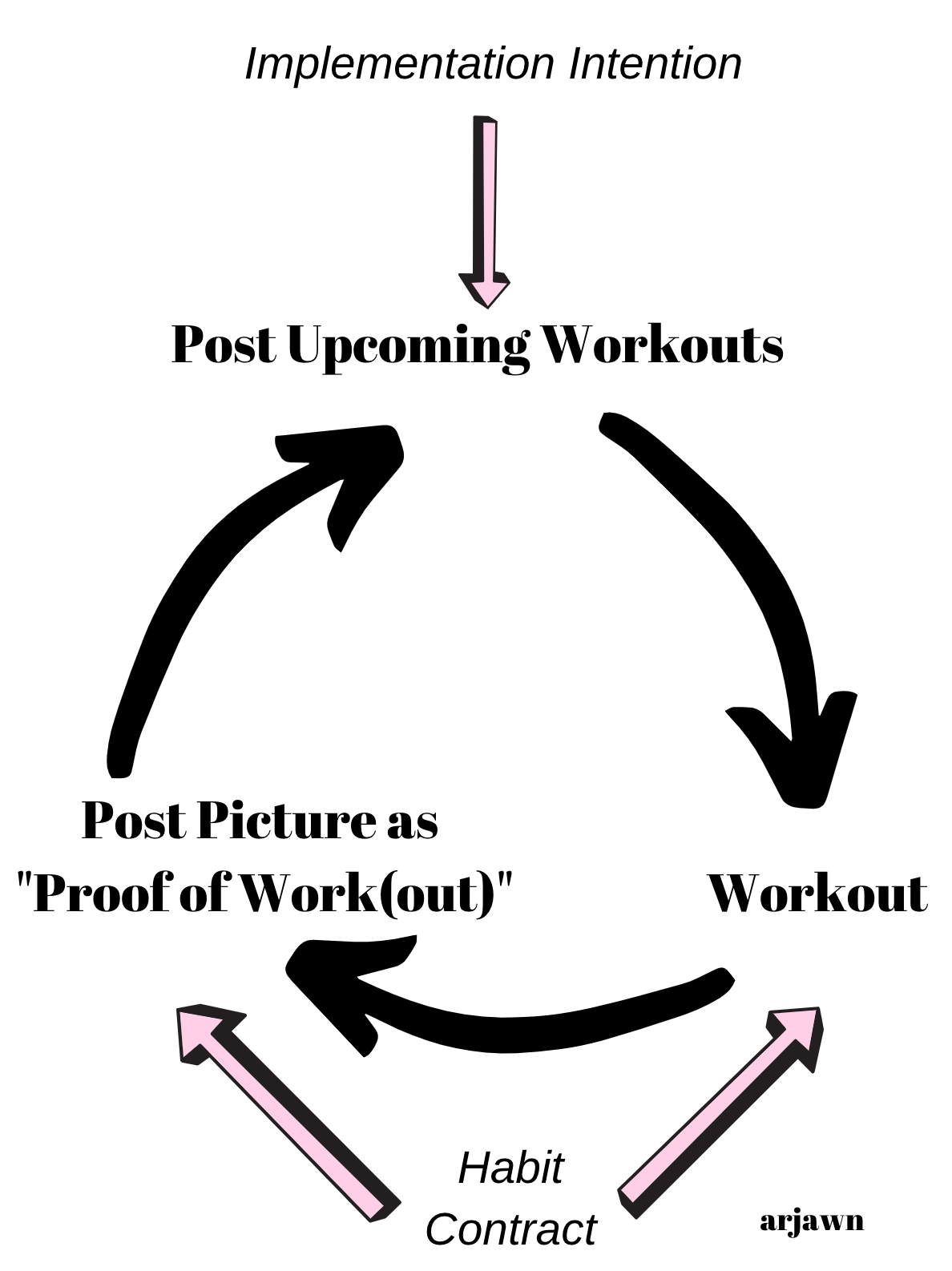

Implementation Intentions
Here is how I use Pemvee:
- On Sunday I open my calendar and the Pemvee app
- I then enter the workouts I am committing to doing in the upcoming week: in the app, I enter the workout name, workout time and workout location for every workout and it appears on the “upcoming” feed
When users post their workouts in advance this addresses my first and second goal in building this app:
“A way to make all exercise ‘public’ before it happens”
There is now a feed of “upcoming” exercise ☑
“An easier way to coordinate exercise with friends (vs email and text)”
There is now a centralized place to go to know when, where, and what exercise friends are doing. Also, a friend can easily click “I’m in” and send me a text to let me know they’d like to join a workout with me. ☑
However, there’s more to the act of entering your upcoming workouts. Every Sunday, when I add my upcoming workouts to Pemvee, I am completing an implementation intention (side note: I didn’t realize that researchers had a term for this until I read the book Atomic Habits). To apply an implementation intention to your exercise habits, you fill out this sentence:
I will WORKOUT-NAME at WORKOUT-TIME in WORKOUT-LOCATION
As simple as this sounds it works. Here is a study highlighted in Atomic Habits showing how powerful implementation intentions can be in building better exercise habits:
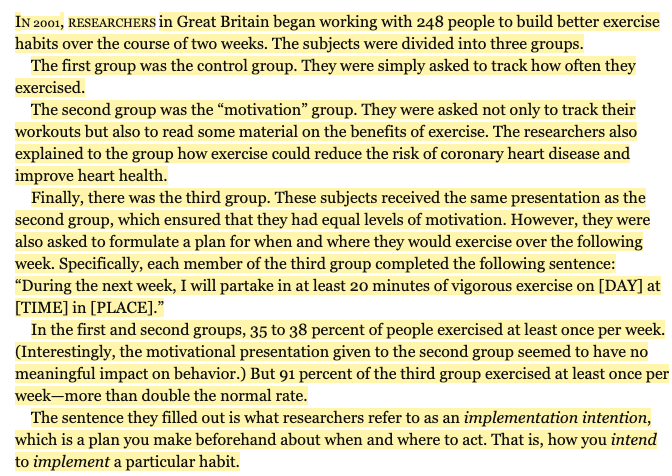

But it gets even better. The best part of implementation intentions is that you can apply them to any habit. The way to apply an implementation intention to any habit is to fill out this sentence:
I will BEHAVIOR at TIME in LOCATION
Atomic Habits provides a few examples:
Studying:
I will study Spanish for twenty minutes at 6 p.m in my bedroom
Meditation:
I will meditate for one minute at 7 am in my kitchen
Marriage:
I will make my partner a cup of tea at 8 a.m in the kitchen
And in the case of Pemvee, Exercise!
I will Jumprope at 6:00 pm in Snow Park, Oakland
When I enter my workouts for the upcoming week on Sunday, not only am I completing an implementation intention but also there are two other major benefits:
- I prioritize exercise: By entering my workouts in advance when I want to do them I can plan other events that naturally pop up around the times I’ve already blocked off for exercise.
- I remove mental friction: By entering my workouts in advance, I don’t need to spend time every morning thinking about when / if I am going to workout because it’s already been decided.
Is it possible to exercise consistently without using implementation intentions? For sure and I’m sure many people do. But I wanted a way to make it harder to bail on a workout and this system works for me. Am I motivated to exercise consistently? Absolutely. But motivation on its own doesn’t mean I will exercise consistently. Here’s a quote on this concept that resonated with me:
Trying to pump up your motivation to stick with a hard habit is like trying to force water through a bent hose. You can do it, but it requires a lot of effort and increases the tension in your life. Meanwhile, making your habits simple and easy is like removing the bend in the hose. Rather than trying to overcome the friction in your life, you reduce it.
Atomic Habits
By entering workouts every Sunday and having them set on my calendar, I am removing the bend in the hose and reducing as much friction as possible for myself.
Social Habit Contracts
Implementation intentions on their own are powerful but what makes them even more powerful is a social habit contract. This contract is automatically created when another person on Pemvee sees the upcoming workouts I have posted.
I have several close friends and my family on Pemvee. Every Sunday, when I post my upcoming workouts for the week I know [read: hope] that one of my friends or one of my brothers, or my mom, or my dad or anyone on the app will see the workouts I have committed to doing.
Knowing that someone is watching is such a powerful motivator. Why? Because in my head, there is now an immediate cost of skipping a workout. Not only am I letting myself down by not sticking to what I committed to but also I am letting other people down as well. James Clear explains this well [and I’ve interjected two comments]:
If you don’t follow through [on your workout], perhaps they [users on Pemvee] will see you as untrustworthy or lazy. Suddenly, you are not only failing to uphold your promises to yourself but also failing to uphold your promises to others… We are always trying to present our best selves to the world.
Every time a new user joins Pemvee, not only can they strengthen their exercise habits by utilizing implementation intentions but also they are strengthening the exercise habits of every other user on the app by creating a habit contract with other users.
In other words, every time a new user joins the app, it creates more value for existing users on the app in terms of positive social pressure via a social habit contract.
If I have friends on the app, I am more motivated to
- workout and
- post a picture as “proof of work(out)”.
By posting a picture I have upheld my promise to myself and to others. Furthermore, this addresses my 3rd desire in building Pemvee:
“A centralized app for my entire workout history across any exercise”
Every time I post an upcoming workout and post a picture from a completed workout, it is stored in my profile. Now at any time I can go to my profile and see my entire workout history across all of my workouts.
In summary here is the habit loop again, utilizing implementation intentions and habit contracts to strengthen my exercise habit:


Lastly, if you want a quick way to test out the power of implementation intentions + social habit contracts here is a fun (or is the right word daunting 😅) challenge:
- Open up Twitter or Facebook.
- Create a post or Tweet thread and write out for the upcoming week the time, location and place you will workout (an implementation intention).
- As you complete workouts post some sort of “proof of work(out)” (screenshot from a tracking app, a picture of yourself with your trainer /instructor/friend post-workout etc!)
I think this will work for most people because
- you are utilizing an implementation intention and
- more importantly, the social habit contract is strong here!
You are broadcasting to your entire Facebook / Twitter network that you are committing to doing a set of workouts and if you bail on a workout, “suddenly, you are not only failing to uphold your promises to yourself but also failing to uphold your promises to others.”
Lastly, habit contracts are fascinating and if you’re looking for more accountability, you can even physically write and sign a habit contract with someone! Here is an example that James Clear provides as well as a template to create your own habit contract: “Template: Habit Contract”
Next, I’ll talk about How I built Pemvee.
How I built Pemvee
Glide
Knowing how to hack also means that when you have ideas, you’ll be able to implement them. That’s not absolutely necessary (Jeff Bezos couldn’t) but it’s an advantage. It’s a big advantage, when you’re considering an idea like putting a college facebook online, if instead of merely thinking “That’s an interesting idea,” you can think instead “That’s an interesting idea. I’ll try building an initial version tonight.” It’s even better when you’re both a programmer and the target user, because then the cycle of generating new versions and testing them on users can happen inside one head.
Paul Graham
I completely stumbled across GlideApps. I was reading this tech crunch article called “Here are the 85 startups that launched today at YC’s W19 Demo Day 1” and as soon as I read the description for Glide, I thought, “this sounds too good to be true”
Glide: There has been a pretty major trend towards services that make it easier to build web pages or mobile apps. Glide lets customers easily create well designed mobile apps from Google Sheets pages. This not only makes it easy to build the pages, but simplifies the skills needed to keep information updated on the site.
I was trying to build a mobile app quickly.
I understood how Google Sheets worked.
Could I really build a well-designed mobile app from a Google Sheet page?
I went to the Glide website and decided to give it a try. Fast forward a few hours and in one night I had built a working MVP (Minimum Viable Product).
Why does Glide “work?” In my opinion, Glide follows the Pareto principle, also known as the 80/20 rule: one can build 80% of apps with 20% of the features. Furthermore, the “back end” = where all the app information is stored is a Google Sheet. Google Sheets are very intuitive because… chances are most of us have spent time (or a lot of time 😅 ) in Excel / Google Sheets. Therefore the learning curve is much less steep compared to picking up native mobile app development.
For my use case, I found the Pareto principle to hold true and also found the Glide documentation to be very robust making the learning curve even less steep. Therefore I was able to build and iterate extremely quickly.
To visually show this iteration, here are screenshots of how Pemvee has progressed up until the current version. Every time I made a change to the app, I was able to do it in one sitting over a few hours max.
MVP v1: This was built using Coda.io and was before I knew of Glide but I am including it to show the full progression:


MVP v2: Added in a map with a location for workouts, a friends tab + links to local gyms:
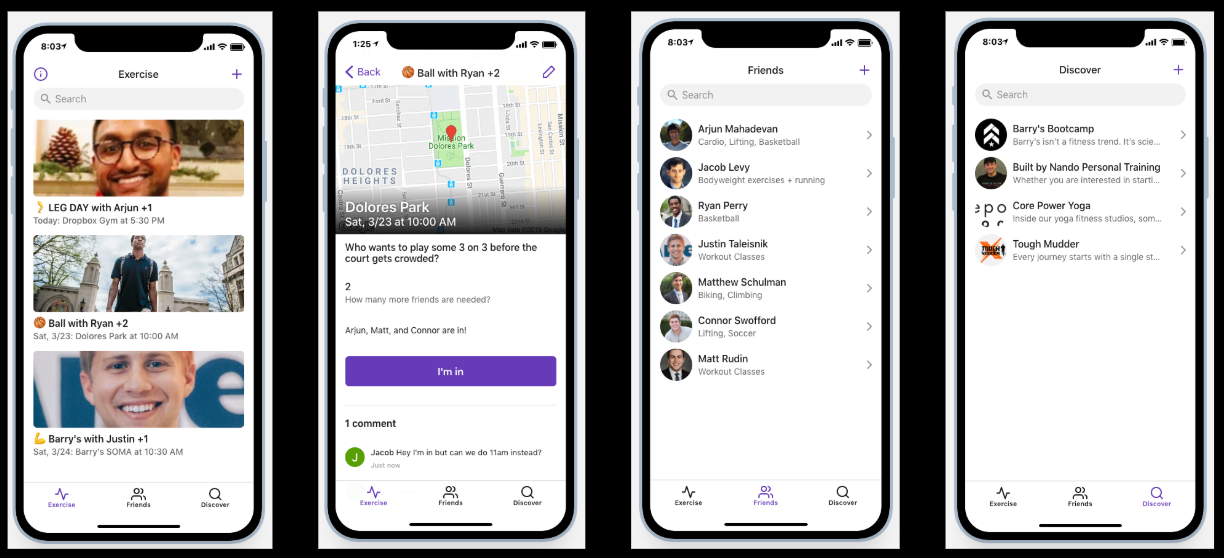

MVP v3: Built a new version of the app for friends in OnDeck including an info tab, an upcoming calendar feed, and group chat:
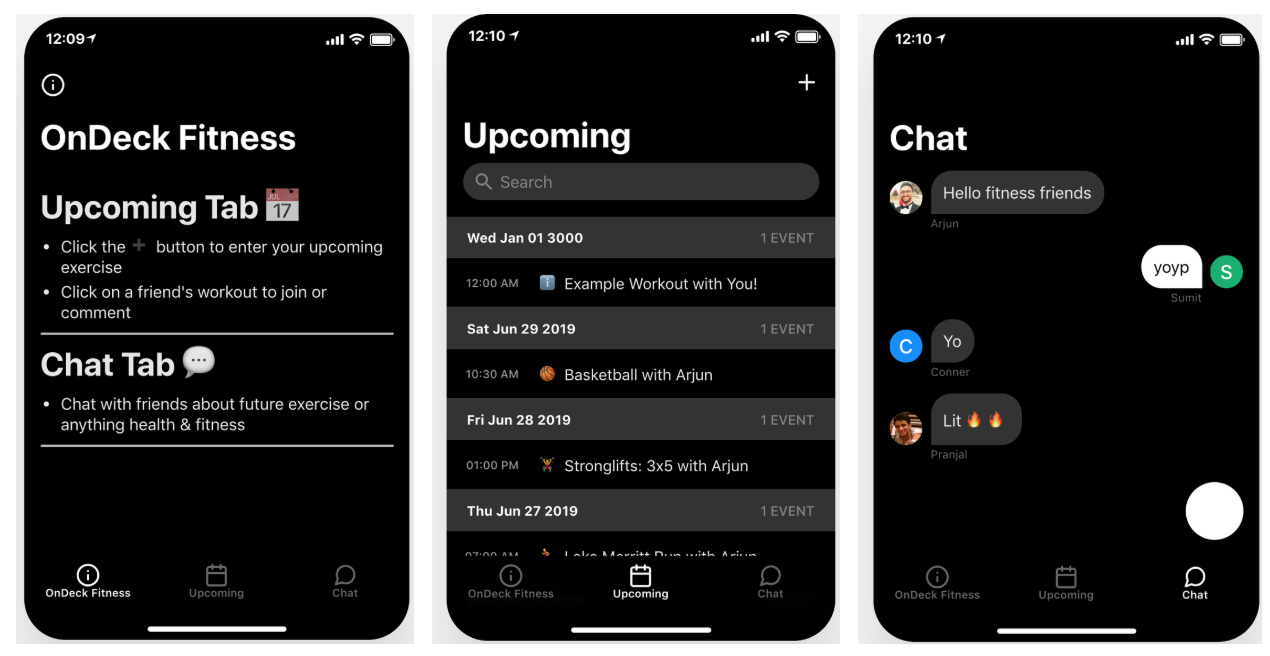

MVP v4: Added an Instagram like completed exercise feed where completed workouts appear in reverse chronological order:
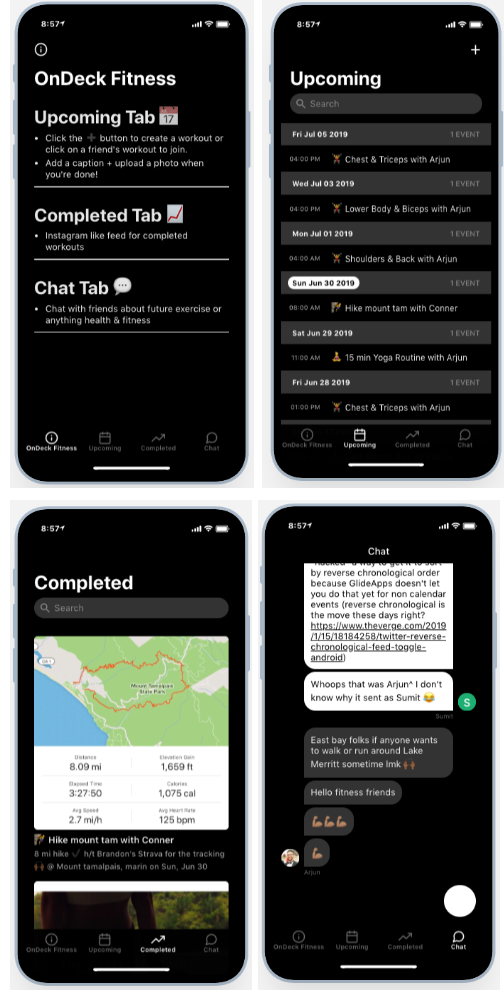

MVP v5: Built a new version of the app for Reddit. Added in a Profile tab where one could create a username, upload a profile picture, set a “goals” status, & see all their upcoming workouts in their profile:


MVP v6: Added a workout history gallery to user’s profiles and hacked together a way to send push notifications to users when someone comments on your post by using Twilio + Zapier:
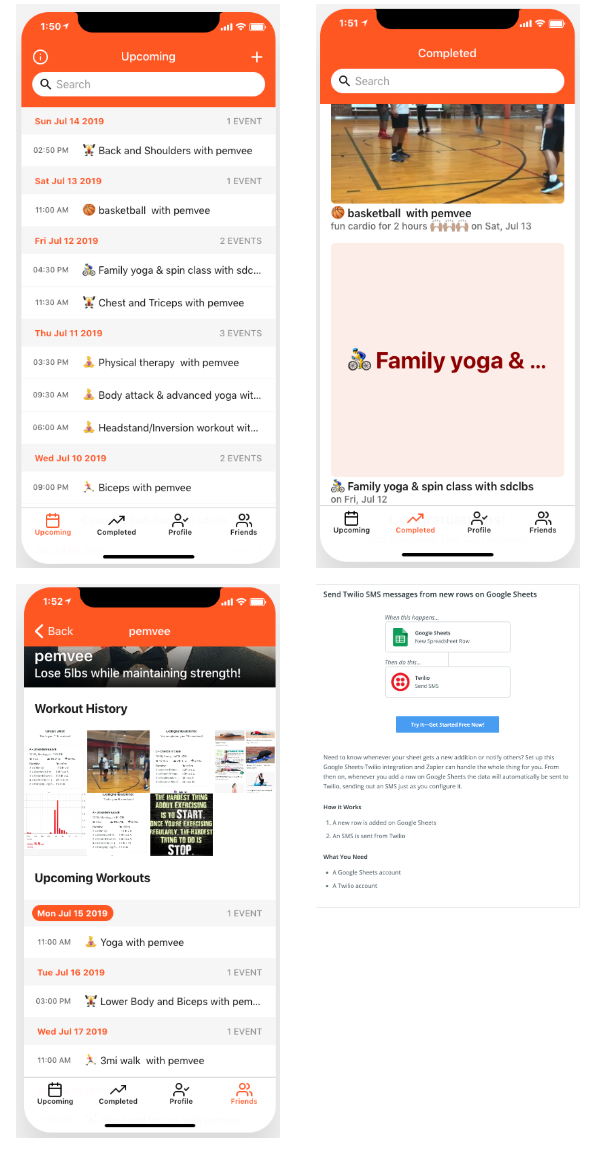

Current Version.


I noted above that I could make changes to the app (large or small) in one sitting over a few hours. But I could also make changes to the app while I was interviewing someone. The above “progress pics” don’t reflect this but this capability was incredible to have in my back pocket. For example, during a live user interview, I could instantaneously re-order the tabs in the app or change the layout of the app within a tab and get feedback from users. Some of the other benefits which were great during interviews/iteration were:
- I didn’t need a test flight link to share the app; users could scan a QR code or just enter the app URL into a browser of their choice
- The app works on web & mobile web OR it can be downloaded and pinned to your home screen as a “native app.” This allowed basic testing of which platform might initially be best for Pemvee.
Looking back at the above “progress pics” I am glad I have developed such a strong grasp of Glide. It has given me what feels like a superpower: I can build a prototype or working MVP for almost any mobile app in one sitting. Asking someone: “Hey, is this business/app a good idea?” is not ideal. Why? Because it invites everyone to lie to you at least a little:
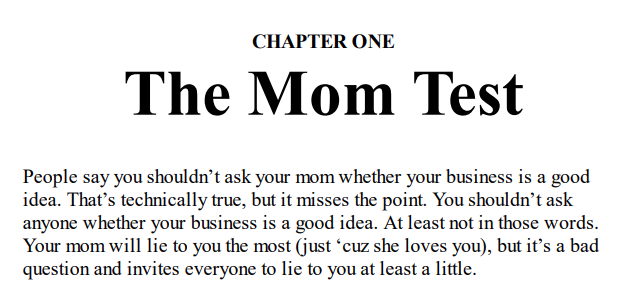

An improvement to this question is putting an actual prototype in their hands or better yet a working MVP. Then you can start to get the feedback we all need at the early stage of building something. The feedback that starts to helps answer the million-dollar question:
Did I [actually] make something people want?
Paul Graham
Glide launches new features extremely quickly and I have been impressed by the rapid pace. This has happened several times so far:
- Me: Awesome, feature X is available, I will add it to the app
- *adds feature to app*
- Me: Crap users really want feature Y / I think this is needed in the app. I need to switch back to React Native now so I can add the feature.
- *starts coding in React Native knowing it will take some time*
- Glide: “hey we’ve released feature Y!”
- *Repeat step 1) ^*
However, as of this writing, there are things which aren’t available (yet) on Glide that I would love to have in Pemvee. For example, here are some features missing in Glide that one could code in React Native:
- The ability to add friends
- Direct Messages (vs Group chat only)
- An Onboarding flow
- The ability to upload video from the camera roll
- Push notifications
It’s possible to hack some of these but not all of them. For example, I built a hack for basic push notifications by:
- Creating a Twilio account
- Creating a Zapier account
- Using some excel logic to map a user’s phone number (if they entered it) to their workout post or “proof of work(out)” picture
- Using this Zapier Zap to send a Twilio SMS message to the “poster” whenever someone comments on your post = a new row is added to the “Comments” sheet
I honestly wouldn’t be surprised if Glide adds all these features in the future. But if I want these features in Pemvee or any other app I might build now I need to switch to native code. But for someone who
- had an idea and
- wanted to build something very quickly to put in user’s hands
Glide allowed me to:
- “build an initial version tonight” and
- because I was the “programmer” and the “target user” the cycle of generating new versions of the app and testing them on users started happening in my head. This feeling truly is incredible.
The last thing I’ve thought about is if I had started building in React Native right away vs using Glide, would I have made “ faster progress?” This is a tricky question. On one hand, I’d be that much more proficient in React Native so I could iterate more quickly in native code. On the other hand, it would have taken me several weeks to build an initial version of the app which, in hindsight, I would have ended up iterating on anyway due to the rapid feedback I was able to get using Glide.
Therefore, my current thought is (and I very much might be rationalizing my answer here based on what I did with Pemvee in order to justify how I spent my time): I think there is value in building with Glide to narrow one’s sights before 100% jumping into native code. This is what I will strive to do for future mobile or web apps I build.
The Future of No-Code
I realized that I had actually used several no-code tools to build Pemvee:
But this is really just scratching the surface of the no-code tools that exist today. Rather than try to compile all the no-code tools that I know of, I’ll direct you to Ben Tossel who has already done this for us on his website makerpad.co 🙌. His site is definitely worth checking out if you have any interest in seeing the plethora of no-code / low-code tools available today.
On the topic of no-code, I enjoyed reading this post from Caleb Kaiser, growth @ Angel List, who explains that: No Code platforms have been powering the web for decades:
To understand the impact of these platforms, think of it this way. WordPress, one of the oldest coding-optional website management platforms, is also the most ubiquitous CMS on the web, powering over 25% of the world’s websites. Pile on the popularity of Shopify, Wix, Squarespace, and others, and you’re looking at a massive chunk of the modern internet being run on No Code or low-code platforms.
The newer generation of these platforms, think Zapier, Airtable, and Webflow, allow you to take things a step further and actually build full-stack web applications without touching a line of code. When it comes to democratizing the power of software, it’s hard to think of an industry making more of an impact.
Because of this impact, these companies also are incredibly successful financially. Shopify and Wix are both publicly traded, Squarespace is gearing up for an IPO, Airtable is a unicorn, and Webflow just raised a Series A at a $350 million dollar valuation.
Lastly, given the rise in no-code / low-code tools, a question that naturally arises is:
Should I learn to code?
The following answer really resonated with me and it will (for now) be the answer I borrow and use if someone asks me “should I learn to code or not?”
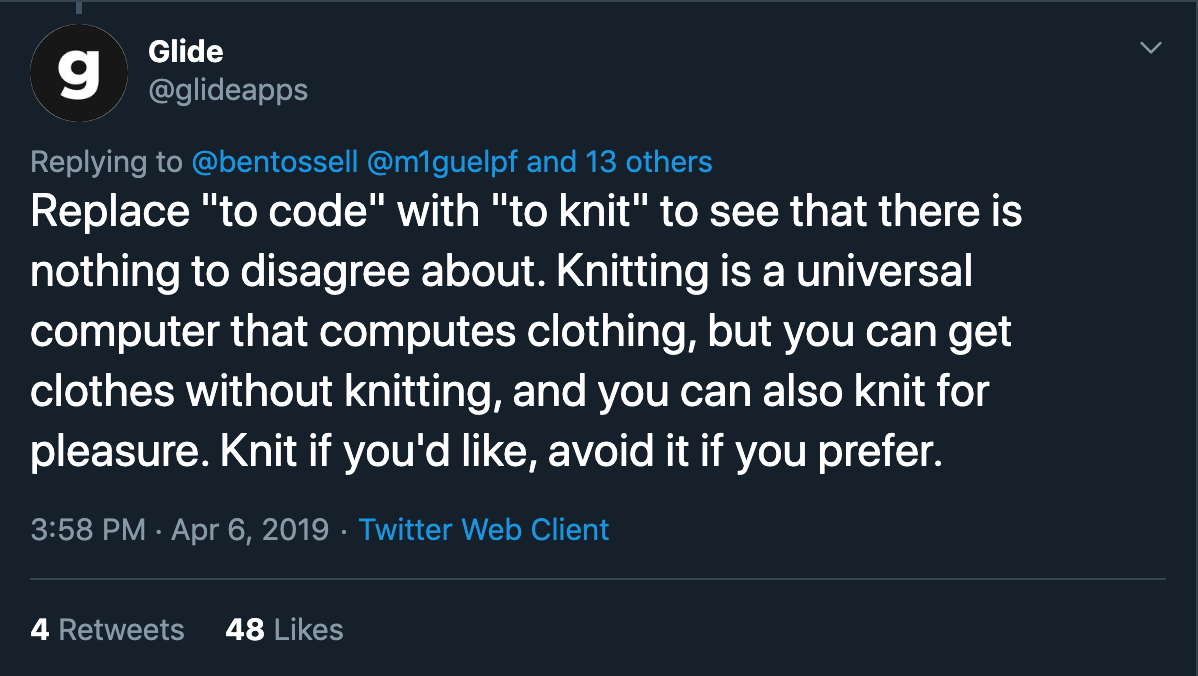

What’s next?
The future of social fitness apps
A crowded market is actually a good sign, because it means both that there’s demand and that none of the existing solutions are good enough.
Paul Graham
There are a ton of health & fitness, social fitness, and motivation related apps + companies out there. As I come across a new app or company in the space, I add it to a table. The table is at 50+ and counting and I’m sure I’m missing many companies:
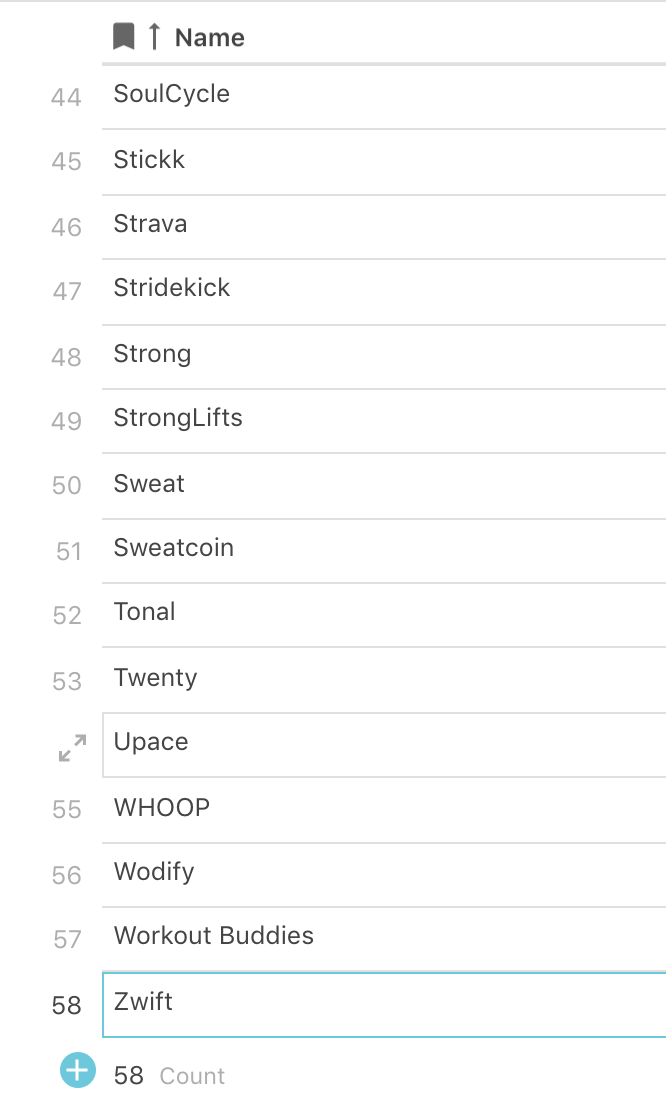

Not only is the health and fitness market a crowded market but also it is a huge market: “the $30 billion health and fitness industry in the U.S. has been growing by at least 3–4% annually for the last ten years and shows no signs of slowing down anytime soon.”
People also spend a lot on their health and fitness: “The study surveyed 1,350 US adults aged 18 to 65 and found that the average American spends $155 per month on their health and fitness, that’s $112,000 in their entire lifetime and $13,000 more than a public four year college education which averages about $98,440. Included in that number, Americans on average spend $33 on gym memberships, $56 on health supplements, $35 on clothing and accessories for working out, $17 for healthy meal plans and $14 on trainers.”
And in my opinion, there are some compelling answers to “why now?” in terms of why a social fitness network could exist now. There are two pieces of content I keep coming back to on this topic.
- This tweet thread from D’Arcy Coolican:


2. This blog post from Ted Wang:
We believe there are tremendous opportunities for entrepreneurs to create companies that enable us to use our phones to improve our well-being. We are particularly encouraged that so many smart people who built the first wave of mobile app technology are now looking to build mission driven companies with greater social impact.
– Ted Wang
Given how crowded the market is and how much people spend on health and fitness and the above thoughts on “Why now?”, does this imply that “there’s demand” and is it also true that “none of the existing solutions are good enough?” Also why doesn’t a single social network around exercise exist? Or to rephrase why can’t one exist?
First, I think social fitness networks already exist. Many of them actually:
- Reddit — there are a plethora of highly engaged and active subreddits centered around fitness. Some examples: r/fitness & r/bodybuilding (and many more)
- YouTube — countless Youtube accounts exist where trainers and other fitness influencers post videos and engage with subscribers. Some examples: Thomas DeLauer & POPSUGAR Fitness (and many more)
- Facebook — there are many groups centered around different types of exercise. Some examples: Check out the search results for “fitness” here
- Strava — designed by athletes, for athletes, Strava’s mobile app and website connect millions of runners and cyclists through the sports they love. Website here
- Instagram — there are many fitness influencers and users who post-workout pics and advice. There are over 70M posts with the #fitnessmotivation
- Text groups — a chat with friends who like a certain type of exercise or a group where people post workouts for accountability. For example, I am in one of these groups for pickup basketball.
Each of the above is a type of “fitness social network” varying in size (a text group vs a Reddit subreddit) and exact form (broadcast via Youtube vs posts + comments via Facebook). But at the end of the day, the above consist of groups of highly engaged people who self select into the above networks (one or many).
A juicier question, in my opinion, is: “are none of the existing solutions good enough?” I think that many of the above solutions are fantastic and have thousands (if not more) of loyal engaged users. I also think the above networks can better motivate people to exercise and improve their health and fitness.
But again, there are so many different apps and sub-communities out that this naturally leads me to ask what I consider to be the juiciest (and most lucrative) question:
Why can’t a single social fitness network exist?
In other words, is there a way to stitch together aspects of existing social fitness networks today into one standalone, gargantuan app or platform?
To answer this as well as evaluate the potential arc of how a gargantuan fitness social network might grow, cheers to Eugene Wei for providing an incredible framework to analyze this. Everything quoted or “in quotes” below is from his incredible article: Status as a Service.
(Major note: I’m very much thinking out loud when applying his framework and would love to hear people’s thoughts on the following #strongopinionslooselyheld)
First social capital, then utility
Come for the fame, stay for the tool? Foursquare was this for me. In the beginning, I checked in to try to win mayorships at random places. These days, Foursquare is trying to become more of a utility, with information on places around you, rather than just a quirky distributed social capital game. Heavier users may have thoughts on how successful that has been, but in just compiling a database of locations that other apps can build off of, they have built up a store of utility. IMDb, Wikipedia, Reddit, and Quora are more prominent examples here. Users come for the status, and help to build a tool for the commons.
If a fitness social network were to start this way, it might look like (as Eugene Wei mentions):
There are many fitness subreddits that exist today and while many people are members of these thriving communities I don’t think a single fitness subreddit will grow into this hypothetical gargantuan social fitness network because they’re working “back” towards utility.
Utility, but no social capital
Some companies manage to create utility for a network but never succeed at building any real social capital of note (or don’t even bother to try). Most messaging apps fall into this category. They help me to reach people I already know, but they don’t introduce me to too many new people, and they aren’t really status games with likes and follows. This bottom right quadrant is home to some businesses with over a billion users, but in minimizing social capital and competing purely on utility-derived network effects, this tends to be a brutally competitive battleground where even the slimmest moat is fought for with blood and sweat, especially in the digital world where useful features are trivial to copy.
If a gargantuan fitness social network were to start this way, it might look like:
- FB Messenger for coordinating gym workouts
This is a brutally competitive battleground and most messaging apps fall into this category. Therefore without adding in any aspect of social capital, this route to seems extremely unlikely especially because text and FB messenger is already used today as the default way to coordinate workouts. Furthermore, I think that social capital is such a powerful lever and the complete lack of it (in this example) would be a barrier to a hypothetical gargantuan social fitness network.
Social capital, but little utility
If a gargantuan fitness social network were to start this way, it might look like:
Y = professional athletes, former athletes, people who hit a certain “in shape criteria” etc, whatever makes Y as exclusive as possible (to start). Another classic example of the social capital first approach is Facebook starting as a social network with a key qualification needed in order to join:
…you had to be a student at Harvard. By requiring a harvard.edu email address, Facebook drafted off of one of the most elite cultural filters in the world. It’s hard to think of many more powerful slingshots of elitism.
Furthermore, Eugene Wei notes that the most interesting company to debate in this quadrant of “Social Capital, but little Utility” is… Facebook:
…it’s worth wondering how things might differ for Facebook today if it had succeeded in pushing further out on the utility axis. Many people I know have just dropped Facebook from their lives this past year with little impact on their day-to-day lives. Among the obvious and largest utility categories, like commerce or payments, Facebook isn’t a top tier player in any except advertising.
I think this approach can indeed work but the key to making it a durable and sustainable network is eventually adding in some form of utility:
When a social network loses heat before it has built utility, the fall can come as quickly as the rise…
But I actually think a massive social fitness network exists in this quadrant:
There are many fitness influencers and athletes who have accumulated lots of social capital by building large health and fitness followings on Instagram. And Instagram is starting to add in utility as well which might make it durable for these fitness influencers:
In the end, I think most social networks, if they’ve made this journey, need to make a return to utility to be truly durable. Commerce is just one area where Instagram can add more utility for its users.
Yes, Instagram is gargantuan, but from a “social fitness” perspective I do think that there needs to be more utility. This leads us to the last approach which I find very interesting.
First utility, then social capital
This is the well-known “come for the tool, stay for the network” path.
If a gargantuan social fitness network were to start this way, it might start by looking like:
- Superhuman for coordinating exercise with friends
I find this compelling and fascinating because I don’t think anything exactly like it exists today.
Problem this solves: it is a pain to coordinate workouts via text or spammy group messages. But the big question here is: Is it possible to initially create a 10x improvement in utility over existing workout coordination methods (texting a friend or FB Messenger groups)? The 10x improvement here would have to be ease/speed of coordination. As more and more friends coordinate workouts using this app, the network would then grow.
Why might someone want to coordinate workouts? Because 1) exercise can be extremely social and 2) working out with someone can increase the duration and intensity of one’s workout by up to 200%. But to be intellectually honest a major assumption I’m making here is: if someone had the option of working out with someone else vs working out alone and the coordination/effort needed to find someone to workout was almost negligible, then I am assuming that a vast majority of people would prefer to workout with someone else.
Another layer that could be combined with the above “Superhuman for X” approach is:
- Dropbox for saving, tracking, and sharing any workout
Problem this solves: there are many apps people have to use across different types of fitness: Strava for biking, Strong for weightlifting etc. My hypothesis is that centralizing these apps and creating a platform-agnostic system-of-record (why I included the Dropbox reference) for saving, tracking and sharing workouts would provide utility to people.
That being said, the ultimate hypothetical solution in this quadrant would then tackle both of these problems at once. Note: I do not think Pemvee does this anywhere near well enough to create a 10x improvement in utility for users; but what I have found interesting, is my learnings from iterating and testing with users has led me in this direction in terms of my thinking. Therefore the best way to test this hypothesis would be to build an app which looks like:
- Superhuman x Dropbox for coordinating x centralizing workouts
Again, the Superhuman x Dropbox analogy refers to:
- speed and ease of coordination (“Superhuman”)
- platform-agnostic system-of-record centralization (“Dropbox”)
The ultimate question would then be does this combination of ease of coordination x system-of-record-centralization solve a big enough pain point for people — is it a pain killer? — or is this solution merely a nice to have — is it a vitamin?
What’s next for Pemvee
I describe Pemvee now as ClassPass x Instagram for fitness with friends but when I compare the current app to the hypothesized super-utility version above, it becomes pretty clear what areas are lacking if not entirely missing:
- a public feed of workouts to coordinate with friends (“ClassPass”) → this on its own doesn’t actually make it faster or less painful to coordinate a workout. I think making the workouts public is step one but there needs to be an incentive to use the app beyond the implementation intention. A 10x ease of coordination could be that incentive.
- a centralized home for your workout history (“Instagram”) → this is a home for photos a user might upload, but it doesn’t provide centralization for all the other types of exercise one might do and record on another app. If this could be done passively and platform/app agnostically it could provide even more utility to users.
Despite this, Pemvee was a blast to build and as I mentioned earlier I think of building something you want as the ultimate win-win outcome: even if this app is something I use individually to strengthen my exercise habits, then that would be a great outcome. But if it can help others, then it turns in to a fantastic outcome and I think a way to get there is as hypothesized above.
If you’re interested, if you want to create your own version of Pemvee in its current form to use with your friends here is a link to a template.
Additionally, if there is interest, I’d be happy to put together a step by step guide for how I built this app + record a video of me building the app from scratch to share with others. Let me know 🙌!
And if you made it this far, here is how I came up with the name Pemvee:
- Goal: add momentum to people’s lives through exercise
- Momentum = Mass x Velocity
- P = MV
- PMV
- Pemvee
I hope you enjoyed this write-up and I’d love any feedback. I can also (try to) answer any questions people have about health and fitness, habits, flywheels, Glide, Pemvee, no-code tools…or really anything else that comes to mind.
News
Berita
News Flash
Blog
Technology
Sports
Sport
Football
Tips
Finance
Berita Terkini
Berita Terbaru
Berita Kekinian
News
Berita Terkini
Olahraga
Pasang Internet Myrepublic
Jasa Import China
Jasa Import Door to Door
Situs berita olahraga khusus sepak bola adalah platform digital yang fokus menyajikan informasi, berita, dan analisis terkait dunia sepak bola. Sering menyajikan liputan mendalam tentang liga-liga utama dunia seperti Liga Inggris, La Liga, Serie A, Bundesliga, dan kompetisi internasional seperti Liga Champions serta Piala Dunia. Anda juga bisa menemukan opini ahli, highlight video, hingga berita terkini mengenai perkembangan dalam sepak bola.

